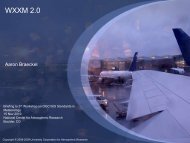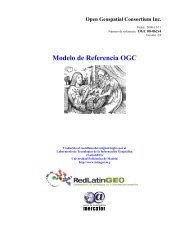Metadata Profile for AIXM - Open Geospatial Consortium
Metadata Profile for AIXM - Open Geospatial Consortium
Metadata Profile for AIXM - Open Geospatial Consortium
Create successful ePaper yourself
Turn your PDF publications into a flip-book with our unique Google optimized e-Paper software.
WorkArea Wiki » <strong>AIXM</strong> 5.1 Workarea » <strong>Metadata</strong> <strong>Profile</strong> <strong>for</strong> <strong>AIXM</strong><br />
<strong>Metadata</strong> <strong>Profile</strong> <strong>for</strong> <strong>AIXM</strong><br />
Last modified by EDUARD POROSNICU on 2010/11/02 15:45<br />
Comments (4) | Attachments (13) | History | In<strong>for</strong>mation<br />
Edit<br />
Action<br />
Edit<br />
- Scott will draft the Requirements document first<br />
- we organise a Webex with the authors of the document (those present at the first<br />
meeting)<br />
- then the whole AVDWG<br />
Workflow<br />
Edit<br />
The following workflow will be adopted in the creation of the <strong>Metadata</strong> <strong>Profile</strong> <strong>for</strong><br />
<strong>AIXM</strong>:<br />
• Gather sources - background on metadata standards.<br />
• Gather Requirments <strong>for</strong> the profile<br />
• Agree the Requirements<br />
• Propose guidance on how to comply with the requiements<br />
1 <strong>Metadata</strong> Lanscape<br />
Edit<br />
The following sources have been identified as background on metadata:<br />
ISO Standards<br />
- ISO 19115<br />
- ISO 19115 Corrigendum - see here notes from the discussion in the AvDWG about<br />
the mandatory requirements<br />
- ISO 19119<br />
- ISO 19119 - Extensions of the service metadata model<br />
- ISO 19139<br />
- ISO 639-2 language codes<br />
- ISO 8601 - dates and times<br />
European Implementing Rules
- INSPIRE Implementing Rule and supporting guide<br />
<strong>Metadata</strong> Requirements document<br />
Proposed structure of the document:<br />
- explain that if you need to use metadata, there are a number of fields imposed as<br />
mandatory by the metadata schema; these are analysed first;<br />
- then analyse the specific requirements of various stakeholder groups: ICAO, ADQ,<br />
AMDB, etc.<br />
- provide a UML schema that sumarisses the elements in ISO 19105 which satisfy<br />
these requirements.<br />
<strong>Metadata</strong> implementation document<br />
AMDB RTCA/EUROCAE<br />
This document also contains metadata requirements and as we want to enable<br />
publication of AMDB files from <strong>AIXM</strong> data sources,<br />
Existing Aviation <strong>Profile</strong>s<br />
- <strong>AIXM</strong> <strong>Metadata</strong> profile: attach:<strong>Metadata</strong><strong>Profile</strong><strong>AIXM</strong>5.1Draft2010-03-26.doc<br />
- EAD implementation: attach:metadataproposalv2.zip and<br />
attach:<strong>AIXM</strong><strong>Metadata</strong>Design.doc<br />
- eTOD: attach:TODWG9-WP3eTOD<strong>Metadata</strong>1.0.doc<br />
- "Aeronautical <strong>Metadata</strong> <strong>Profile</strong> based on Geographic International Standards",<br />
Madrid University, 2009.<br />
- recent development by contractors <strong>for</strong> Eurocontrol SES: an ADQ profile, also called<br />
"aviation domain metadata proposal": attach:<strong>Metadata</strong>modelstrippedV10.pdf<br />
Non Aviation<br />
- ANZLIC<br />
- Content Standard <strong>for</strong> Digital <strong>Geospatial</strong> <strong>Metadata</strong>, NSDI<br />
- MMI: http://marinemetadata.org/semanticframework<br />
2 Gather requirements<br />
Edit<br />
Source <strong>for</strong> requirements<br />
ICAO Annex 15 Amdt 36<br />
gives minimum:<br />
1. the name of the organisation or entity per<strong>for</strong>ming the function -> lineage<br />
2. the function per<strong>for</strong>med. [That is: originating, transmitting or manipulating<br />
the data] -> inside lineage<br />
3. the date and time of the operation. -> this is the date inside the lineage
element<br />
Note that this include a list of values CI_DateTYpeCode which has values:<br />
+ creation = "origination"<br />
+ publication = "provision"<br />
+ revision = "manipulation"<br />
ADQ Annex I Part C: <strong>Metadata</strong><br />
Note: This is Europe only<br />
Note: (which includes metedata about an attribute)<br />
The metadata <strong>for</strong> the data set specifications defined in Part A and Part B shall include<br />
the following items, as a minimum:<br />
(a) the data originator of the data;<br />
(b) amendments made to the data;<br />
(c) the persons or organisations that have interacted with the data and when;<br />
(d) details of any validation and verification of the data that has been per<strong>for</strong>med;<br />
- use the "DQ_DataQuality" element, with the DQ_Element child that allows to<br />
record<br />
(e) effective start date and time of the data;<br />
(f) <strong>for</strong> geospatial data:<br />
- the earth reference model used,<br />
- the coordinate system used;<br />
Decision: do not use in the metadata, just specify in the GML; we do not want to<br />
duplicate the GML data; if required by a specific product, then the<br />
MD_ReferenceSystem should be filled using the in<strong>for</strong>mation about the CRS,<br />
collected from the GML encoded data underneath;<br />
(g) <strong>for</strong> numerical data:<br />
Note that we consider that as numerical data in AI:<br />
- the statistical accuracy of the measurement or calculation technique used,<br />
- the resolution: what this means<br />
We could use the DQ_Element/DQ_QuantitativeResult to capture:<br />
- errorStatistics as confidence level<br />
- valueUnit and value as resolution of the measuring device<br />
If we adopt the ADQ definition, which means "number of digits". This is explicit in<br />
GML, as trailing zeros are not lost. This could be a problem in a database storage<br />
system where trailing zeros are removed. There<strong>for</strong>e, such system should store the<br />
resolution of the incoming data values and re-store it when exporting <strong>AIXM</strong>/GML<br />
data.<br />
It could also mean the resolution of the measuring device, in which case there is no<br />
easy to find solution in ISO 19105. The initial <strong>AIXM</strong> metadata profile by FAA<br />
proposed it as an extension. Possible to be captured as an extension of the MD profile,<br />
see the rules in Annex C. Or to be also considered. As accuracy in <strong>AIXM</strong> is at the<br />
property level -> see elevated point, then it would make sense to put the value in an<br />
<strong>AIXM</strong> extension at the same level; that would be data specific: distance, angle,<br />
angular distance (seconds);
It seems that in AMDB the hres is the resolution of the measuring device. To be<br />
checked with working group 44 how they are using this value and what they put in the<br />
AMDB files as hres/vres values.<br />
Could be the resolution of the original measuring device that was used to measure the<br />
element/position; use the MD_SpatialResolution/.../MD_Distance (see INSPIRE)<br />
- the confidence level as required by the ICAO standards referred to in points 1 and 12<br />
of Annex III and in other relevant ICAO standards;<br />
(h) details of any functions applied if data has been subject to<br />
conversion/trans<strong>for</strong>mation;<br />
(i) details of any limitations on the use of the data.<br />
current <strong>AIXM</strong> profile<br />
At message level:<br />
1. constraints: classification codes: restrcited, confidential, top-secret.<br />
2. constraints: access and use of the metadata. Legal constraints. Security<br />
constraints.<br />
At feature level:<br />
1. identitification in<strong>for</strong>mation. Who owns the feature<br />
2. datestamp <strong>for</strong> when metadata was produced.<br />
At timeslice level:<br />
1. measure class - in<strong>for</strong>mation about any measurements<br />
2. measEquipClass - equipment used to capture the measurements<br />
3. data integrity - degree of assurance that data has not been altered since<br />
origination<br />
4. horizontal resolution<br />
5. vertical resolution<br />
6. citation, system name<br />
7. digital certificate<br />
8. contact in<strong>for</strong>mation - address, phone.<br />
9. process certification - DO200A, CHAIN compliant, ISO compliant.<br />
Other Sources<br />
eTOD<br />
Note: check if we have covered the eTOD in full; do not <strong>for</strong>get about resolution,<br />
accuracy, integrity, CRC value;<br />
Aviation DWG<br />
FAA: metadata requirements <strong>for</strong> Airport GIS<br />
ISO 19115 has a mandatory elements.
Content Standard <strong>for</strong> Digital <strong>Geospatial</strong> Data (FGDC-STD-001-1998)<br />
This is under review and may add international elements<br />
AirMat<br />
NGA<br />
1. language<br />
2. vertical extent<br />
3. topic category<br />
1. data status<br />
See comments at bottom of page.<br />
Notes<br />
To do: document the requirements in the same way that they were documented in the<br />
Inspire IR (Part B)<br />
Note: <strong>Metadata</strong> can indicate which source has generated that element; but how to<br />
define he rules by which the data is integrated (which is the authortative source <strong>for</strong><br />
each attribute, what order to apply <strong>for</strong> selecting the value if not present where<br />
expected, but present in lower authority sources This is to be discussed later in detail,<br />
but to be mentioned in the current work<br />
3 Agree requirements<br />
Edit<br />
How do we set about ratifying the requirements<br />
Perhaps as input to the <strong>AIXM</strong> CCB.<br />
4 Propose means of compliance<br />
Edit<br />
XML Schema solutions<br />
- document as in the Inspire Implementing Rules using 19139 (eventually with<br />
extensions)<br />
- document as in the Inspire Implementing Rules using our own custom schema (as<br />
derived by Galdos from 19193 )<br />
In both implementation solutions we might need to describe:<br />
- metadata requirements <strong>for</strong> International data exchange (ICAO level)<br />
- metadata requirements <strong>for</strong> data originators (these might be specific to each
Region/State and might require extensions to the ISO 19139 schema; <strong>for</strong> example,<br />
attachments if they are not supported by the ISO 19139 schema).<br />
Core and Extension<br />
3 levels of metadata<br />
1. Core. Minimum set<br />
2. Complete. Still within scope of ISO 19115<br />
3. Extended. Go beyond ISO 19115






